Astronomy 1101 --- Planets to Cosmos
Todd Thompson
Department of Astronomy
The Ohio State University
Low-Mass Stars
- Low-Mass Star = M < 4 Msun
- Stages of Evolution of a Low-Mass star:
- Main Sequence star
- Red Giant star
- Horizontal Branch star
- Asymptotic Giant Branch star
- Planetary Nebula phase
- White Dwarf star
Main Sequence Phase
During the main sequence phase, the energy source is Hydrogen fusion in the core.
What happens to the He created by H fusion? Core is too cool to ignite Helium fusion. The star slowly builds up an inert (not fusing!) He core. Each of the He nuclei produced by the PP chain (star less massive than about 1.2 Msun) or the CNO cycle (stars more massive than about 1.2 Msun) just sits at the center of the star until the end of the main sequence lifetime.
Main-Sequence (H-burning) Lifetime: t = energy reservoir/luminosity ~ M/L ~ 1/M^3:
- ~10 Gyr for a 1 Msun star (e.g., Sun)
- ~10 Tyr for a 0.1 Msun star (red dwarf)
Core Hydrogen Exhaustion
Inside the star:
- the inert He core collapses & starts to heat up.
- H burning zone moves into a thin shell surrounding the core
- Collapsing core heats the H shell above it, driving the fusion
faster.
- More fusion = more heating, so that Pressure > Gravity
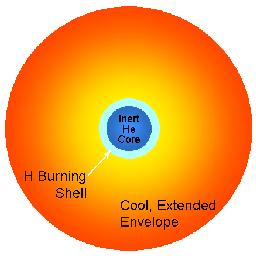
(Graphic by R. Pogge)
Outside the star:
- Envelope expands and cools
- Star gets brighter and redder & climbs up the
Giant Branch.
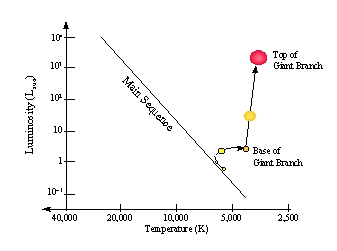
(Graphic by R. Pogge)
It takes a 1 solar mass star about 1 Gyr (about 1/10th of its main sequence lifetime) to climb the Red Giant Branch
- He core contracting & heating, but still no fusion
- H burning to He in a shell around the core
- Huge, puffy envelope ~ size of orbit of Venus
At the Tip of the Red Giant Branch the core is compressed enough that it finally reaches the critical temperature to burn He:
- Tcore reaches 100 Million K
- Ignites He burning in the core in a flash.
At 100 Million K, a new fusion source ignites: the Triple-alpha Process (just 3 He nuclei getting together: an "alpha" particle is just a He nucleus (2 protons and 2 neutrons)).
This is the fusion of three 4He nuclei into one 12C
(carbon) nucleus:

A secondary reaction forms Oxygen from Carbon & Helium:

(Graphic by R. Pogge)
When this occurs, the star leaves the Giant Branch.
Inside:
- Starts generating primary energy from He burning in the core.
- Gets additional energy from an H burning shell surrounding the core.
Outside:
- Gets hotter and bluer.
- Star shrinks in radius, getting fainter.
The new energy source helps the star begin to regain Hydrostatic and
Thermal Equilibrium. As it does so, it moves onto the
Horizontal Branch.
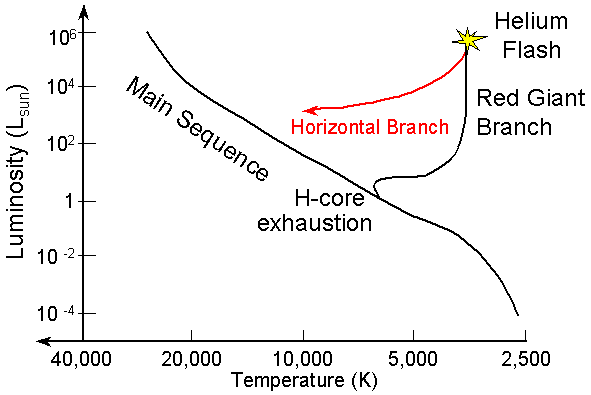 (Graphic by R. Pogge)
(Graphic by R. Pogge)
Structure:
- He-burning core
- H-burning shell
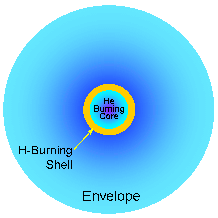
(Graphic by R. Pogge)
The Triple-alpha Process is inefficient at producing energy, so it
can only last for about 100 Myr. There is less energy for every gram of material fused, partially because of neutrinos being produced, and partly because of the physics of nuclei. You just get less total energy from this process than you do from the PP chain or the CNO cycle.
While it goes on, the star steadily builds up a C-O core, but it is
still too cool to ignite Carbon fusion. This phase is analogous to the main sequence phase. The star is burning He into heavier elements (C and O), and while it's doing that it is too cold to ignite CO fusion. So, it builds an inert core of C and O.
After 100 Myr, the core runs out of Helium for Triple-Alpha fusion.
Inside:
- C-O core collapses and heats up (but, no CO fusion!)
- He burning shell outside the C-O core
- H burning shell outside the He burning shell
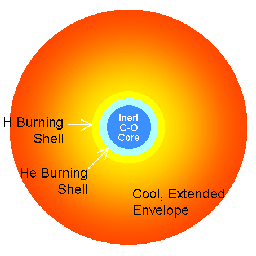
(Graphic by R. Pogge)
Outside:
- Star grows rapidly in radius and cools
Climbs the Giant Branch again, but at a higher effective Temperature
than the Giant Branch, so it ascends with a bluer color, putting it
slightly to the left of the original Giant Branch on the H-R Diagram (the "Asymptotic" Giant Branch:)
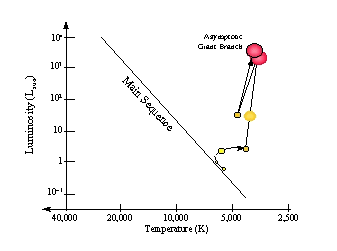
(Graphic by R. Pogge)
The star becomes an Asymptotic Giant Branch Star
He burning is very temperature sensitive: Triple-alpha fusion
rate is proportional to T40, so very tiny changes in temperature lead to big changes in the fusion rate. This can destabilize the outer layers of the star: Small changes in T lead to large changes in fusion energy output.
Star experiences huge Thermal Pulses that destabilize the
outer envelope.
Core-Envelope Separation
Rapid Process: takes ~105 years
Outer envelope gets slowly ejected (fast wind)
C-O core continues to contract:
- With the weight of envelope taken off, the core heats up less
- It never reaches the Carbon fusion ignition temperature of 600 Million K
Core and Envelope separate physically.
Planetary Nebula Phase
Expanding envelope forms a nebula around the contracting C-O
core:
- Ionized and heated by the hot central core.
- Expands away to nothing in ~104 years.
The star briefly becomes host to a Planetary Nebula
The hot C-O core is exposed, and moves quickly to the left on the H-R Diagram
at nearly constant luminosity and increasing temperature.
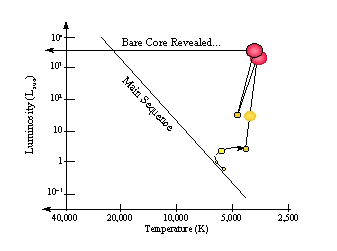
(Graphic by R. Pogge)
Images of Planetary Nebulae
Planetary nebulae are among the most beautiful objects in the sky. Below
are links to PNe pretty-picture sites:
Core Collapse to White Dwarf
The contracting C-O core becomes so dense that a new gas law takes
over. It turns out that this new gas law is NOT the ideal gas law of P = n k T.
Degenerate Electron Gas:
- Pressure becomes independent of Temperature
- P grows rapidly & soon counteracts Gravity
Collapse halts when R ~ 0.01 Rsun (~ Rearth)
- Degenerate core becomes a White Dwarf
We will learn more about White Dwarfs in Unit 3.
Updated/modified Sept 2014, Todd Thompson
Copyright Richard W. Pogge,
All Rights Reserved.








